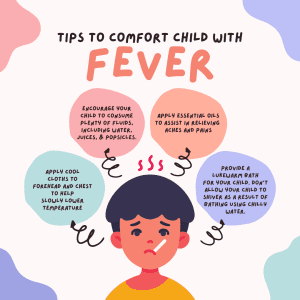Kids get sick. All three of my daughters have been back at school for about two months now. At their young age, this means they tend to unintentionally share germs and come home with runny noses and fevers. When kids get sick, we worry when we notice a fever and we might begin conducting late-night Dr. Google searches. This only leaves us amped up, confused, and unsure. Should I take them to the doctor? How high of a fever is too high?
Fever is a symptom of many common childhood illnesses, so here is some straight talk about fever to help us all feel more confident when our kid has a fever.
Medical Talk
Fever is actually a symptom of infection (either bacterial or viral) and a condition in the body that is regulated by our hypothalamus. Fever can be an early or late symptom depending on the illness. A fever is defined as a temporary rise in body temperature greater than 100.4 degrees Fahrenheit. The technical talk for fever goes like this:
- Fever is caused when the hypothalamus detects pyrogens, biochemical substances that are released by destroyed cells or viral/bacterial cells.
- Pyrogens initiate the hypothalamus (known as the body’s thermostat) to maintain a higher body temperature and therefore cause a fever, which helps to destroy the infection in the body.
- Fever is part of our body’s “good guy” defenses.
But none of that is helpful in the middle of the night when your child has a fever, so here is the “mom” talk.
Fever should alert us that our kids are sick. However, fevers are not harmful to our bodies. Therefore, my strongest advice is to watch your child and not the number on the thermometer. You are the expert on your child. Children can have a severe illness with a low fever or be comfortable with a high fever. Typically, if a child is lethargic, in pain, or not wanting to drink any fluids, these symptoms indicate you NEED to visit your pediatrician. Fever and not drinking fluids can quickly lead to dehydration, so again, you are the expert in watching how your child looks and behaves. These are practical steps to take when your child has a fever:
- Decide if you want/need to give medication.
- Offer frequent cool and hydrating drinks.
- Dress your child in comfortable, light clothing for the current season.
- Monitor for other symptoms such as cough, headache, diarrhea, or ear pain.
The majority of childhood illnesses are viral infections and only need support and comfort measures while the infection runs its course. In the first few years, young children get an average of 12 viral infections a year—this means basically once a month we have a sick child.
Taking a temperature
Tympanic (ear) and temporal (forehead) are the most accurate and most comfortable methods of measuring temperature. Oral is considered just as straightforward but is not as accurate due to outside temperature influences such as drinks and food. Rectal is the absolute most accurate but least comfortable for the child! I don’t recommend rectal unless specifically directed by your doctor, as it usually doesn’t matter if a child has a 101-degree fever versus a 102.5-degree fever so a forehead temperature will give you the same information faster. CLICK HERE for a quick and easy printout I created to reference when taking your child’s temperature!
Fever Relief
Medicine
Two medications are typically used to ease and manage our kids’ fevers at home— acetaminophen and ibuprofen (also known as Tylenol and Motrin/ibuprofen). Fevers are a natural body response to infection, but they can also make us feel bad by causing muscle aches, headaches, sweating, chills, and just an overall crummy feeling. Tylenol and Motrin are both excellent at temporarily easing these discomforts. Pediatricians will provide you with a weight-based dose when your child is under 24 months of age. After that, you can use the dosage charts on the medicine box.
CLICK HERE to access a simple medication tracking sheet to record when and which medicine you gave your child most recently. As a parent, you may choose to use one or both medicines for your child. Remember, fever does not have to be treated with medicine, as it is a symptom and not harmful to our body.
Easy fever comforts

There are, of course, ways to soothe the discomforts of fever without medicine, and these comforts can be used alone or while taking fever-reducing medicine. Let me know in the comments—How do you comfort your child when they have a fever?
Questions & Answers
Here are frequently asked questions that I get as Pediatric RN:
Should I wake up my child at night to give them fever-reducing medicine?
This is a personal choice, but my advice is if a child has a fever but is sleeping and resting comfortably they don’t need to be woken up for medicine. Fevers are not harmful and we primarily treat them to relieve the discomfort of fever. When we wake the child we may be disturbing the rest they need to recover from the illness. I know people sometimes worry that the untreated fever will keep rising and lead to febrile seizures or brain damage—however, there is no evidence this is true.
How do I dress my child when they have a fever?
I recommend simply dressing your child for the season. If it is summer and a child has a fever, dress them in regular light summer clothing. If it is winter when your child is sick, you should choose a set of long sleeve comfortable clothes. Overdressing because the child feels cold/chilly due to fever will trap heat around their body.
If I choose to give fever-reducing medicine, what is the best way to keep my child comfortable?
Tylenol and Motrin are both recommended every six hours, per standard MD advice. Therefore, if your child needs frequent medication to be comfortable, you alternate these medications, which allows you to give medication every three hours.

Ibuprofen is not recommended for children under the age of six months or if a child is vomiting (because it is a stomach irritant) or dehydrated. See the example schedule to get a better visual of how to alternate medications.
Facts
Here are some facts about fever compared to what you may have heard.
| What you may have heard: | Fact: |
|---|---|
| Fevers are harmful. | Fevers are part of the body’s immune response and help to fight infections in our body. |
| Treating a fever promptly helps the fever and illness go away sooner. | Giving fever-reducing medicine, such as Motrin and Tylenol, relieves the discomfort that comes with fever. As soon as the medicine wears off, the fever will return, and giving medicine has no effect on the length of the illness. |
| Untreated fever leads to febrile seizures and brain damage. | Treating a fever does not prevent febrile seizures from occurring. Febrile seizures only occur in 4% of children and do not cause long-term harm. Children who have febrile seizures don’t have an increased risk for other seizures or learning disorders. |
| All fevers should be treated with medicine. | Children who are uncomfortable due to fever can be given medicine for the discomfort. Fevers typically don’t make children uncomfortable until they are above 103°F. Fever is regulated by the hypothalamus and the body does not create harmful fevers. Therefore, treating or not treating a fever is a personal choice for caregivers. |
| When a fever can’t be broken, it is more serious. | Viral and bacterial infections cause fevers, and the type of infection will determine the length and severity of illness, not the response to anti-fever medication. |
| Starve a fever and feed a cold. | This old saying can be helpful!
A child’s appetite does decrease when they have a fever, and this is normal. Our bodies don’t want to spend energy digesting food when we are fighting infections. |
In the End
I think fever is our friend—alerting us when our kids are sick and helping their bodies to fight infection. We get to make our own personal choice about how to help our kids with their fever, and most of the time a fever is nothing to lose our cool over.
Be sure to “like” this article and share your fever-comforting methods or other fever questions in the comments!











